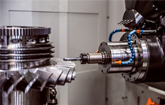DETROIT, Nov. 25, 2020 /PRNewswire/ -- Stratview Research announces the launch of a new research report on Cured-In-Place Pipe (CIPP) Market by Pipe Diameter Type (<1 Foot, 1-2.5 Feet, 2.5-5.0 Feet, and >5.0 Feet), by Resin Type (Polyester, Vinyl Ester and Epoxy), by Fabric Type (Polyester, Glass, and Other Fabrics), by Cure Type (Hot Water, Steam and UV Cure), by Weaving Type (Woven, Nonwoven, and Others), by Coating Type (Polypropylene, Polyethylene, Polyurethane, Non-Coated, and Other Coatings), and by Region (North America, Europe, Asia-Pacific, and Rest of the World), Trend, Forecast, Competitive Analysis, and Growth Opportunity: 2020-2026.
This comprehensive report, from Stratview Research, forecasts the CIPP market from 2021 to 2026 in terms of both value and volume shipment. The report estimates the short- as well as long-term repercussions of the COVID-19 pandemic on the demand for CIPP at the global, regional, as well as country level. Also, the report provides the possible loss that the industry will register by comparing pre-COVID and post-COVID scenario. The vital data/information provided in the report can play a crucial role for market participants as well as investors in the identification of low-hanging fruits available in the market as well as to formulate growth strategies in order to expedite their growth process.
Cured-in-Place Pipe (CIPP) Market: Highlights
Cured-in-place pipe (CIPP) is one of the trenchless (or no-dig) rehabilitation processes used to repair pipelines. It is a non-invasive, jointless, seamless, pipe-within-a-pipe, which is used for rehabilitation of sewer pipe, industrial gas pipe, potable water pipe, and gravity pipes. It can be performed inside a pipe with a diameter range of 6" to 120". This trenchless pipe rehabilitation method causes minimal disruption to traffic, work productivity, and people at home. It is installed by municipalities or utilities by accessing piping systems from city manholes. CIPP liners manufacturing must be compliant under various standards, regulated by ASTM and has to follow the emission norms of different regulatory bodies such as OSHA regulation.
There are various trenchless technologies used for pipe rehabilitation such as CIPP, SIPP, pipe bursting, and slip lining. Among all, CIPP is the most widely used technology and alone accounts for more than three-fourth of the trenchless pipe rehabilitation market. The global CIPP market grew at a healthy rate over the past five years; however, it is anticipated that the market will record a slowdown in its growth trajectory amid the pandemic. Based on the analysis of previous downturns, such as The Great Recession (2008) and other crisis/pandemics, as well as detailed discussions with industry players and experts, Stratview Research estimates that the trenchless technology market including CIPP business will record a minimal impact of the COVID-19 pandemic. The CIPP market is estimated to rebound at a great pace from 2021 onwards, filling all the voids (market loss) generated due to the pandemic, ultimately driving the market to land to the value of US$ 3.0 billion in 2026.
The shrinking global economy may imprint a short-term impact on the spending of municipalities and governments for infrastructure projects, leading to some delays in the market demand. However, the long-term prospect seems promising with huge growth opportunities. Aging potable and sewage water structure, increasing spending by municipalities and utilities on rehabilitation, increasing awareness about the benefits of trenchless methods, and high-performance of CIPP over competing technologies are major growth drivers of the global CIPP market.
Click Here to Browse the Table of Contents of the Report: https://www.stratviewresearch.com/toc/287/Cured-in-Place-Pipe-CIPP-Market.html
In terms of diameter type, <1-foot diameter pipe is likely to remain the dominant segment by 2026. The demand for CIPP in the <1-foot diameter pipe is mainly attributed to the large installed base for sewer and potable water applications across regions. 8" diameter pipe is a standard size and has been one of the largest used pipelines across the world.
Based on the resin type, polyester resin-based CIPP is expected to remain the dominant resin segment, whereas epoxy resin-based CIPP is expected to be the fastest-growing segment in the post-pandemic market developments. Polyester resins are predominantly used in sewer and stormwater pipe rehabilitation, owing to its high flexural modulus, low tensile elongation, and good chemical resistance. Further, its lower cost as compared to vinyl ester and epoxy resins elevate its demand. Epoxy resin does not have HAPs (hazardous air pollutants) or cause less VOC (volatile organic compounds) emissions and is one of the eco-friendliest choices for CIPP. Epoxy resin based CIPP is mostly used for the rehabilitation of potable water pipelines as it's the only resin that meets the NSF/ANSI 61 potable water requirements.
Based on the fabric type, polyester felt based CIPP is likely to remain the most dominant fabric type, whereas glass fabric-based CIPP is expected to be the fastest-growing fabric type in the market during the forecast period. Polyester fabric exceeds the desired tensile strength and meets the ASTM D461 standard at a competitive price compared to other fabrics. It is considered a superior fabric for optimum resin carriage coupled with high surface tension. Glass fabric is the preferred choice for CIPP where curing is done through UV. The main reason for using glass fabric liner with UV curing, instead of water or steam-cured felt liners, is that felt curing generates by-products that negatively affect the environment.
Based on the coating type, PP-coated CIPP is likely to remain the most dominant segment of the market, owing to its excellent elasticity, ease of handling, an attractive price-to-performance ratio, thicker than the conventional coatings, firm bonding with the felt, and resistant to hydrolysis and chemical attack.
Register Here for a Free Sample of the Exhaustive Report: https://www.stratviewresearch.com/Request-Sample/287/Cured-in-Place-Pipe-CIPP-Market.html
In terms of region, North America is projected to remain the largest market for CIPP during the forecast period. The USA is the largest market for CIPP in North America as well as in the world. Most of the pipeline construction in the region was done post-world war and needs rehabilitation with CIPP is the most suitable method for pipe rehabilitation. There is already high penetration of the CIPP technology in developed economies, especially the USA, Germany, and Japan. Asia-Pacific currently has low penetration of trenchless technology but is likely to be the fastest-growing region.
The global market for CIPP is moderately consolidated with the presence of more than 100 players. The supply chain of this market comprises raw material suppliers, tube manufacturers, CIPP liner manufacturers, resin impregnators, CIPP installers, municipalities, and utilities. Key players in the CIPP market are Per Aarsleff A/S, Ashimori Industry Co. Ltd., iMPREG GmbH, Insituform Technologies, Inc. (Part of Aegion Corporation), IPR (Inland Pipe Rehabilitation), Layne Inliner, LLC, Perma-Liner Industries, LLC, RELINEEUROPE AG, SAERTEX multiCom® GmbH, SAK Construction, LLC, and Sekisui SPR Americas, LLC. Developing thinner, stronger, and eco-friendly liners, execution of mergers & acquisitions, and formation of contracts with installers and utilities are the key strategies adopted by the key players to gain a competitive edge in the market.
Report Features
This report provides market intelligence in the most comprehensive way. The report structure has been kept such that it offers maximum business value. It provides critical insights on the market dynamics and will enable strategic decision making for the existing market players as well as those willing to enter the market. The following are the key features of the report:
- Market structure: Overview, industry life cycle analysis, supply chain analysis.
- Market environment analysis: Growth drivers and constraints, Porter's five forces analysis, SWOT analysis.
- Market trend and forecast analysis.
- Market segment trend and forecast.
- Competitive landscape and dynamics: Market share, product portfolio, product launches, etc.
- Attractive market segments and associated growth opportunities.
- Emerging trends.
- Strategic growth opportunities for the existing and new players.
- Key success factors.
This report studies the global CIPP market and has segmented the market in seven ways, keeping in mind the interest of all the stakeholders across the value chain. Following are the seven ways in which the market is segmented:
Cured-In-Place Pipe (CIPP) Market, By Diameter Type
- <1-Foot Diameter (Regional Analysis: North America, Europe, Asia-Pacific, and Rest of the World)
- 1-to-2.5-Feet Diameter (Regional Analysis: North America, Europe, Asia-Pacific, and Rest of the World)
- 2.5-to-5-Feet Diameter (Regional Analysis: North America, Europe, Asia-Pacific, and Rest of the World)
- >5-Feet Diameter (Regional Analysis: North America, Europe, Asia-Pacific, and Rest of the World)
Cured-In-Place Pipe (CIPP) Market, By Resin Type:
- Polyester (Regional Analysis: North America, Europe, Asia-Pacific, and Rest of the World)
- Vinyl Ester Resin (Regional Analysis: North America, Europe, Asia-Pacific, and Rest of the World)
- Epoxy Resin (Regional Analysis: North America, Europe, Asia-Pacific, and Rest of the World)
Cured-In-Place Pipe (CIPP) Market, By Fabric Type:
- Polyester Felts (Regional Analysis: North America, Europe, Asia-Pacific, and Rest of the World)
- Glass Fabrics (Regional Analysis: North America, Europe, Asia-Pacific, and Rest of the World)
- Other Fabrics (Regional Analysis: North America, Europe, Asia-Pacific, and Rest of the World)
Cured-In-Place Pipe (CIPP) Market, By Curing Type:
- Hot Water (Regional Analysis: North America, Europe, Asia-Pacific, and Rest of the World)
- Steam (Regional Analysis: North America, Europe, Asia-Pacific, and Rest of the World)
- UV (Regional Analysis: North America, Europe, Asia-Pacific, and Rest of the World)
Cured-In-Place Pipe (CIPP) Market, By Weaving Type:
- Woven (Regional Analysis: North America, Europe, Asia-Pacific, and Rest of the World)
- Nonwoven (Regional Analysis: North America, Europe, Asia-Pacific, and Rest of the World)
- Others (Regional Analysis: North America, Europe, Asia-Pacific, and Rest of the World)
Cured-In-Place Pipe (CIPP) Market, By Coating Type
- PP-Coated CIPP (Regional Analysis: North America, Europe, Asia-Pacific, and Rest of the World)
- PE-Coated CIPP (Regional Analysis: North America, Europe, Asia-Pacific, and Rest of the World)
- PU-Coated CIPP (Regional Analysis: North America, Europe, Asia-Pacific, and Rest of the World)
- Non-Coated CIPP (Regional Analysis: North America, Europe, Asia-Pacific, and Rest of the World)
- Others (Regional Analysis: North America, Europe, Asia-Pacific, and Rest of the World)
Cured-In-Place Pipe (CIPP) Market, By Region
- North America (Country Analysis: The USA, Canada, and Mexico)
- Europe (Country Analysis: Germany, The UK, Spain, France, and Rest of Europe)
- Asia-Pacific (Country Analysis: Japan, Australia, Singapore, China, and Rest of Asia-Pacific)
- Rest of the World (Sub-region Analysis: Latin America, The Middle East, and Others)
Stratview Research has several high value market reports in the construction and infrastructure industry. Please refer to the following link to browse through our reports:
https://www.stratviewresearch.com/market-reports/Construction-Equipment.html
About Stratview Research
Stratview Research is a global market intelligence firm providing wide range of services including syndicated market reports, custom research and sourcing intelligence across industries, such as Advanced Materials, Aerospace & Defense, Automotive & Mass Transportation, Consumer Goods, Construction & Equipment, Electronics and Semiconductors, Energy & Utility, Healthcare & Life Sciences, and Oil & Gas.
We have a strong team of industry veterans and analysts with an extensive experience in executing custom research projects for mid-sized to Fortune 500 companies, in the areas of Market Assessment, Opportunity Screening, Competitive Intelligence, Due Diligence, Target Screening, Market Entry Strategy, Go to Market Strategy, and Voice of Customer studies.
Stratview Research is a trusted brand globally, providing high quality research and strategic insights that help companies worldwide in effective decision making.
For enquiries,
Contact:
Stratview Research
E-mail: [email protected]
Phone: +1-313-307-4176
SOURCE Stratview Research

WANT YOUR COMPANY'S NEWS FEATURED ON PRNEWSWIRE.COM?
Newsrooms &
Influencers
Digital Media
Outlets
Journalists
Opted In




Share this article